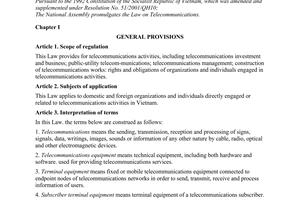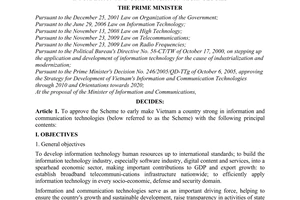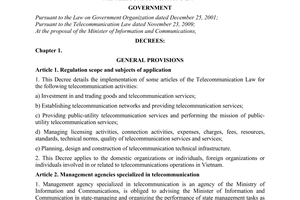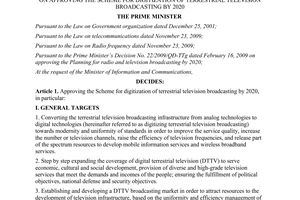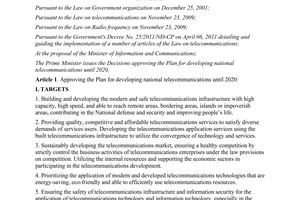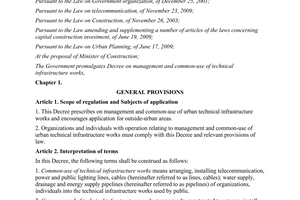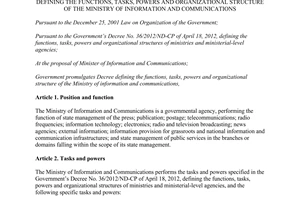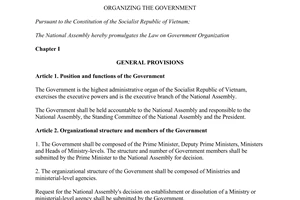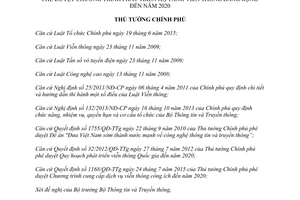Nội dung toàn văn Decision 149/QD-TTg program development broadband telecommunications infrastructure 2020
|
THE PRIME
MINISTER |
THE
SOCIALIST REPUBLIC OF VIETNAM |
|
No. 149/QD-TTg |
Hanoi, January 21, 2016 |
DECISION
APPROVING THE PROGRAM ON DEVELOPMENT OF BROADBAND TELECOMMUNICATIONS INFRASTRUCTURE THROUGH 2020
THE PRIME MINISTER:
Pursuant to the June 19, 2015 Law on Organization of the Government;
Pursuant to the November 23, 2009 Telecommunications Law;
Pursuant to the November 23, 2009 Law on Radio Frequency;
Pursuant to the November 13, 2008 Law on High Technology;
Pursuant to the Government s Decree No. 25/2011/ND-CP of April 6, 2011, detailing and guiding a number of articles of the Telecommunications Law;
Pursuant to the Government s Decree No. 132/2013/ND-CP of October 16, 2013, defining the functions, tasks, powers and organizational structure of the Ministry of Information and Communications;
Pursuant to the Prime Minister s Decision No. 1755/QD-TTg of September 22, 2010, approving the Scheme to early develop Vietnam to be strong in information and communications technologies;
Pursuant to the Prime Minister s Decision No. 32/2012/QD-TTg of July 27, 2012, approving the national master plan on telecommunications development through 2020;
Pursuant to the Prime Minister s Decision No. 1168/QD-TTg of July 24, 2015, approving the Program on provision of public-utility telecommunications services through 2020;
At the proposal of the Minister of Information and Communications,
DECIDES:
Article 1. To approve the Program on development of broadband telecommunications infrastructure through 2020, with the following contents:
I. GENERAL OBJECTIVES
1. To build and develop modem and safe broadband telecommunications infrastructure of large capacity, high speed and nationwide service coverage.
2. To provide diversified broadband telecommunications services of high quality at reasonable charges according to the market mechanism.
II. IMPLEMENTATION PRINCIPLES
1. Modern technology
To apply modern, energy-efficient and eco-friendly telecommunications technologies in line with the global development trend, ensuring the effectiveness of investment in networks, meeting market demands, ensuring social interests and degree of technological perfection in conformity with Vietnam’s conditions.
2. Effective use of telecommunications resources
To effectively use telecommunications resources, frequency spectrum, domain name and Internet address resources and satellite orbit resources to develop modem broadband telecommunications infrastructure and provide diversified services on broadband networks with high quality and reasonable cost.
3. Synchronicity in technology and network
To ensure synchronicity in technology and network between broadband telecommunications infrastructure networks and existing telecommunications networks; the upload speed must be at least 15%-50% of the download speed.
III. SPECIFIC TARGETS
From the viewpoint that telecommunications is an important infrastructure for socioeconomic development, to concentrate resources, maximize the effectiveness of resource exploitation, selectively inherit experience and telecommunications technology achievements so as to fulfill the set targets by 2020:
1. Broadband for communities
a/ Broadband for families
At least 40% of households (or individual subscribers) nationwide will have access to and use fixed-line broadband services. Of these subscribers, at least 60% will be connected with the minimum download speed of 25 Mbps.
b/ Broadband for public telecommunications access points
All public telecommunications access points nationwide will use fixed-line broadband services, of which at least 50% will have fixed-line broadband access with the minimum download speed of 50 Mbps.
c/ Broadband for public libraries
More than 99% of public libraries nationwide will use fixed-line broadband services, of which at least 50% will have fixed-line broadband access with the minimum download speed of 50 Mbps.
d/ Mobile broadband
At least 95% of residential areas will be covered by 3G/4G signals with an average download speed of more than 4 Mbps in urban areas and 2 Mbps in rural areas.
2. Broadband for offices
a/ Broadband for education institutions
More than 99% of education institutions will have broadband connection, of which at least 60% of colleges, universities and research institutes will use broadband services with the minimum download speed of 1 Gbps; at least 60% of general education schools, secondary vocational school and vocational training institutions will have broadband access with the minimum download speed of 50 Mbps.
b/ Broadband for medical examination and treatment establishments
More than 99% of medical examination and treatment establishments nationwide will have broadband connection, of which at least 20% will have broadband access with the minimum download speed of 100 Mbps, 40%-60% of connections will be made at the minimum download speed of 25 Mbps.
c/ Broadband for administrative agencies and enterprises
- All Party and Government agencies and units, socio-political organizations and enterprises will have broadband connection, of which at least 30% of connections will be made at the minimum download speed of 100 Mbps; 40%-60% at the speed of 25 Mbps.
- All websites of Party and Government agencies and units and socio-economic organizations; and e-portals providing public administrative and non-business services will support both Internet Protocol versions 4 and 6 (IPv4 and IPv6).
IV. IMPLEMENTATION SOLUTIONS
1. Telecommunications policies and laws
a/ To complete legal documents guiding the implementation of the Telecommunications Law and the Law on Radio Frequency;
b/ To complete standards and technical regulations on telecommunications equipment, terminal equipment, subscriber terminal equipment and network equipment;
c/ To further improve standards and technical regulations on the quality of broadband telecommunications services;
d/ To complete mechanisms, policies and regulations on telecommunications service licensing, service charge rates and quality, connection, resources and technical infrastructure, network safety, and information security in line with the trend of broadband development, convergence of technologies, services and smart applications, as well as in conformity with Vietnam’s development situation.
2. Markets and services
a/ To create favorable conditions for all economic sectors to participate in the telecommunications market, reduce telecommunications licensing formalities, encourage enterprises to invest in broadband telecommunications network infrastructure and provide diversified services for socio-economic development;
b/ To perform management according to the market mechanism, ensure fair competition, and adopt transparent and non-discriminatory mechanisms and policies. To apply special management mechanisms to enterprises and groups of enterprises that hold dominant market shares so as to ensure fair competition on the market and sustainable development;
c/ To encourage the development of content applications and information technologies on broadband telecommunications infrastructure to meet socio-economic development requirements, such as e-government, e-commerce, e-payment, distance training, environmental protection, natural disaster prevention and control, support for people with disabilities, etc.;
d/ To clearly separate production and business activities from public-utility activities in the telecommunications sector;
dd/ To speed up the implementation of the Prime Minister’s Decision No. 1168/QD-TTg of July 24, 2015, approving the Program on provision of public-utility telecommunications services through 2020, as a basis for synchronous development of infrastructure and universalization of broadband services so as to accelerate the building of an e-government, improve operational quality and effectiveness of state agencies and better serve the people and enterprises;
e/ To study and draw a broadband coverage map for the whole country, develop tools to collect data on the quality of broadband services and users’ experience of service quality. To publicly announce the quality of broadband internet access services;
g/ To step by step change from pre-licensing to post-licensing inspection, reduce procedures for the import of terminal equipment and technical regulation-conformity certification so as to speed up the development of broadband networks and services and reduce pressure on management agencies;
h/ To control broadband access charge rates on the basis of competition according to the market mechanism and the payment conditions of the overwhelming majority of Vietnamese users. To create conditions for all people to have access to broadband services, and boost the creation and diversification of content services.
3. Infrastructure
a/ To develop mechanisms and policies to promote to the utmost the connection and sharing of telecommunications infrastructure among telecommunications enterprises;
b/ To create specific and clear mechanisms and policies on shared use of public intersectoral technical infrastructure. To simplify procedures and standardize and synchronize requirements set by ministries, sectors and localities for licensing telecommunications enterprises to build passive telecommunications infrastructure;
c/ To develop favorable mechanisms and policies to promote and support capable telecommunications enterprises to build international submarine and land optical cable systems with modem and large-capacity technologies to satisfy the need for international connection flows and reserve capacity for international connections. To study and build international internet exchange points in the region;
d/ To study and apply special investment and bidding mechanisms to the implementation of broadband programs so as to ensure the uniformity of broadband networks (without using too many kinds of equipment in the network as it can cause difficulties to the connection, administration, operation, maintenance and repair of equipment) while avoiding overdependence of the network on a single supplier of equipment, leading to dependence on technology and price, causing harms to the interests of enterprises and the country;
dd/ To encourage enterprises to gradually shift to software-defined networking (SDN) and cloud computing technology suitable to each enterprise’s specific conditions so as to provide multiple services on a uniform telecommunications infrastructure.
4. Telecommunications resources
a/ To plan and allocate telecommunications resources according to the requirement of development of broadband telecommunications network infrastructure and services;
b/ To study and develop mechanisms and policies allowing the re-use of some or all of existing frequency bands (850MHz/900MHz/1800MHz) so as to build international mobile telecommunications (IMT) systems to meet the demand for mobile broadband services as well as ensure service quality;
c/ To organize auction for the right to use the frequency bands 2300-2400 MHz, 2500- 2570 MHz and 2620-2690 MHz according to IMT standards;
d/ To speed up the implementation of the Scheme on digitalization of terrestrial television transmission and broadcasting through 2020 under the Prime Minister’s Decision No. 2451/QD-TTg of December 27, 2011, and plan the use of the freed frequency bands 694-806 MHz for building IMT systems and provision of mobile broadband services;
dd/ To license the trial application of technology and provision of mobile broadband services on frequency bands higher than 6 GHz and on that basis, study and plan the use of these frequency bands to serve the deployment of next-generation mobile broadband services;
e/ To step up the application of effective wireless access technologies using higher frequency bands, research and apply technologies allowing the integration of different frequency bands, including licensed and unlicensed ones;
g/ To increase the management and application of Wi-Fi access systems on a broad scale, allowing flexible exchange of flows between Wi-Fi systems and 3G/4G mobile broadband systems;
h/ To plan in detail frequency bands for shortwave (millimeter wave) radio technologies so as to deploy mobile broadband systems and high-capacity point-to-point and point-to-multipoint wireless transmission systems, thus increasing flexibility in building transmission infrastructure for the provision of broadband services in big and populous cities;
i/ To plan frequency bands for the provision of telecommunications applications for people with disabilities, public security, and emergency circumstances on the basis of mobile and fixed- line broadband telecommunications infrastructure;
k/ To accelerate the implementation of the national action plan on IPv6, develop advanced and modem technological applications, effectively use telecommunications resources on the basis of next-generation core networks, broadband access networks and IPv6 networks;
l/ To organize the management, allocation and withdrawal of telecommunications codes and numbers according to master plans and regulations on the management and use of telecommunication numbers. To prioritize the allocation of telecommunications resources for development of modem broadband infrastructure with cutting-edge technologies.
5. Science and technology
a/ To prioritize investment in wire and wireless broadband transmission technologies that are high technologies in the field of information technology;
b/ To organize inter-sectoral and inter-ministerial research and development of applications serving broadband programs;
c/ To accelerate the development and application of technical regulations, standards and application of high technologies in the establishment of networks, provision of services and manufacture and installation of telecommunications terminal equipment, especially broadband network and terminal equipment and smart digital TV receivers so as to reduce costs and quickly universalize telecommunications services of high quality and at reasonable charges among the population;
d/ To update, and encourage enterprises to step by step use, modem, high-capacity and highly effective access network, transmission network, switchable core network and Internet core network technologies in conformity with domestic development demands and global development trends;
dd/ To organize and increase research, training and transfer of technologies and processes for deployment of broadband networks and quick application of scientific and technological research outcomes in practice;
e/ To enhance the application of information technology in the management and operation of broadband telecommunications network infrastructure, provide diversified services so as to reduce costs and prices and increase investment efficiency of telecommunications enterprises.
6. Organizational apparatus and human resources training
a/ To continue strengthening and enhance capacity building for management agencies in the management of telecommunications, internet and radio and television broadcasting and transmission infrastructure in conformity with the technology development trend and Vietnam’s conditions;
b/ To regularly implement programs on improvement of people’s information and communications technology (ICT) skills relevant to socio-economic requirements and local customs and traditions;
c/ The State shall support programs and projects on communication and training of high- quality human resources for the telecommunications sector and improvement of ICT skills for people in rural, deep-lying, remote, border and island areas.
7. Telecommunications infrastructure safety
a/ To elaborate and promulgate regulations on telecommunications infrastructure safety, especially for next-generation core networks, mobile core networks, trunk networks, submarine optical cable networks and private-use information systems serving Party and State agencies;
b/ To ensure safe and reliable operation of the national DNS server system and national internet exchange systems for IPv6 addresses;
c/ To promulgate regulations on network security technology, coordinate with functional agencies in elaborating legal documents on punishment of cybercrime.
8. Resources
a/ To apply incentives prescribed in the Law on High Technologies to enterprises that research and manufacture wireless and wire broadband terminal equipment;
b/ To develop mechanisms and policies to support enterprises to raise capital for the construction and development of modem switching core networks, transmission networks and access networks of high capacity, high speed and large coverage;
c/ To ensure the efficient use of financial assistance from the Vietnam Public- Utility Telecommunications Fund for the performance of the tasks of building broadband telecommunications infrastructure and universalizing broadband telecommunications services according to the Prime Minister’s Decision No. 1168/QD-TTg of July 24, 2015, approving the Program on provision of public-utility services through 2020;
d/ To study and develop mechanisms and policies for efficient use of funds obtained from the auction of the right to use telecommunications resources. To use at least 70% of these funds, especially those from the auction of the right to use radio frequency resources, for re-investment in the development and expansion of broadband telecommunications infrastructure;
dd/ To mobilize foreign development assistance loans for investment in the development of broadband telecommunications infrastructure, especially in rural, deep-lying, remote and island areas;
e/ To proactively support the training of human resources specialized in designing and applying information and telecommunications technologies on broadband infrastructure through telecommunications and information technology universities and research institutions;
g/ The State shall support programs and projects on communications, training of high- quality human resources for the telecommunications sector and improvement of ICT skills for people in rural, deep-lying, remote, border and island areas.
9. International cooperation
a/ To accelerate international cooperation in the field of telecommunications on the basis of clearly determining objectives, principles and solutions suitable to Vietnam’s interests and specific conditions when entering into bilateral and multilateral trade agreements;
b/ To step up cooperation within international organizations and forums on telecommunications. To exchange experience on policy and law making, research, development and application of broadband telecommunications technology and framing of telecommunications managers and technicians;
c/ To attract foreign investment in the field of telecommunications in accordance with Vietnam’s laws and telecommunications master plans;
d/ To create favorable mechanisms and policies for Vietnamese telecommunications groups and enterprises to make offshore investment.
Article 2. Organization of implementation
1. The Ministry of Information and Communications shall:
a/ Assume the prime responsibility for, and coordinate with the Ministry of Science and Technology in, formulating and promulgating national technical regulations on the quality of broadband telecommunications services, safety of national telecommunications and information technology network infrastructure; develop and announce national standards on broadband telecommunications in accordance with law;
b/ Assume the prime responsibility for, and coordinate with related ministries, sectors and provincial-level People’s Committees in, guiding the implementation, management, coordination, supervision, inspection, examination of, and proposing adjustments and amendments to, contents related to broadband services of the Program on provision of public-utility services approved under the Prime Minister’s Decision No. 1168/QD-TTg of July 24, 2015;
c/ Formulate, guide and implement strategies, master plans and plans related to the development of broadband telecommunications through 2020, such as master plans on radio frequencies, telecommunications numbers, passive telecommunications technical infrastructure, technical systems for controlling radio frequencies, and the national action plan on IPv6;
d/ Assume the prime responsibility for, and coordinate with the Ministry of Construction, the Ministry of Transport and related ministries and sectors in, guiding in detail the formulation of master plans and grant of construction permits for passive telecommunications technical infrastructure facilities;
dd/ Assume the prime responsibility for, and coordinate with the Ministry of Industry and Trade in, directing, guiding and managing competition in the telecommunications service market;
e/ Summarize and supervise the implementation of this Program on an annual basis and report on the program implementation results to the Prime Minister;
g/ Coordinate with the Ministry of Planning and Investment in raising capital for achieving the objectives of this Program.
2. The Ministry of Planning and Investment shall assume the prime responsibility for, and coordinate with the Ministry of Information and Communications and the Ministry of Finance in raising capital for achieving the objectives of this Program.
3. The Ministry of Finance shall, in coordination with the Ministry of Information and Communications:
a/ Manage and use the remaining money amounts from the auction of the right to use telecommunications resources for investment in the development of broadband telecommunications infrastructure;
b/ Coordinate with the Ministry of Planning and Investment in raising capital for realizing the objectives of this Program.
4. The Ministry of Industry and Trade shall:
a/ Assume the prime responsibility for, and coordinate with the Ministry of Information and Communications in, inspecting and supervising the terminal equipment market according to the State’s standards and technical regulations;
b/ Direct the Electricity of Vietnam to share its technical infrastructure facilities (including also electric optical cable infrastructure nationwide) with telecommunications enterprises according to the Government’s Decree No. 72/2012/ND-CP of September 24, 2012, on management and use of technical infrastructure facilities.
5. The Ministry of Transport shall coordinate with the Ministry of Information and Communications in directing and guiding units within the transport sector to coordinate with telecommunications enterprises in the shared use of technical infrastructure facilities, especially roadside ones, according to the Government’s Decree No. 72/2012/ND-CP of September 24, 2012, on management and use of technical infrastructure facilities.
6. Provincial-level People’s Committees shall:
a/ Disseminate information via local mass media about this Program’s viewpoints, objectives, orientations and contents to all authorities, sectors and enterprises;
b/ Manage, regulate in detail and organize the shared use of telecommunications infrastructure facilities with other technical infrastructure facilities in their localities;
c/ Direct the settlement and prompt handling of acts of unlawfully obstructing or undermining the construction and use of telecommunications infrastructure in their localities.
7. Enterprises licensed to establish telecommunications networks shall:
a/ Draw up their development plans in conformity with this Program;
b/ Coordinate in the implementation of broadband programs and shared use of passive telecommunications technical infrastructure.
Article 3. This Decision takes effect on the date of its signing.
Article 4. Ministers, heads of ministerial-level agencies, heads of government-attached agencies, chairpersons of provincial-level People’s Committees, chairpersons of Members’ Councils, and directors general and directors of telecommunications groups and enterprises shall implement this Decision.-
|
|
FOR THE PRIME MINISTER |

